
|
GREAT WESTERN
STATIONS MENU
|
|
|
|
A Selection of Great Western Stations
|
|
Evesham
Origin: Oxford, Worcester and Wolverhampton Railway
Opened: 1st May 1852
Closed: Goods - 5th August 1981
|
 |
Known today as the Cotswold line from Norton Junction, east of Worcester to Wolvercote Junction, north west of Oxford, was built in two stages with the first section being that from Norton Junction to Evesham. Opened initially as a single track on the 1st of May 1852, this section was doubled in July 1852. The remainder of the line from Evesham to Wolvercote Junction was completed on the 4th of June 1853 as a single track with a passing place at Charlbury. Doubling of this section began from Charlbury to Wolvercote Junction in 1854, Chipping Camden 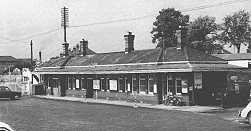 to Evesham in 1855, and finally Chipping Camden to Charlbury in 1858. to Evesham in 1855, and finally Chipping Camden to Charlbury in 1858.
The Ashchurch to Evesham Railway also built a line in 1864 that would later run as far as Barnt Green and this would create an avoiding line for the notorious Lickey Incline. The station at Evesham for this line, later taken over by the MIdland Railway, was constructed alongside the OW&W station.
Freight traffic mostly for the transport of fruit and vegetables for which the area is famous, had always played an important part at Evesham station, and the amount of sidings that were available grew over the years, however by 1923, the amount of these freight workings had increased to such a high level that an additional twelves acres of land was purchased for sidings and goods office accommodation. This 'New Yard' was completed in 1927 and in June of that year, a private siding agreement was made with 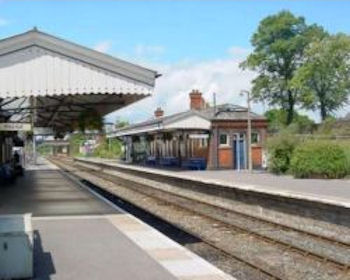 Wisbech Produce Canners. As an example of the importance of the freight work at the station, in 1929, it is recorded that Evesham loaded 2,608 fruit wagons in August alone. Wisbech Produce Canners. As an example of the importance of the freight work at the station, in 1929, it is recorded that Evesham loaded 2,608 fruit wagons in August alone.
In 1930, a 20 ton weighbridge was installed in addition to bulk petrol storage at the site. In the December of that year, it was agreed that Wisbech Produce Canners could lease three acres of the New Yard sidings, and to assist with this arrangement, another warehouse was built at the yard. By 1932 the traffic being dealt with in the New Yard had further increased as Wisbech - now taken over by the National Canning Company - had built a new factory and a new siding was built for the waste produced from fruit and pea-podding machines.
An important change was made at Evesham in 1931 when the LMS and the GWR stations were placed under the control of the LMS stationmaster. As late as 1956, freight workings still played a major part at Evesham with 22,000 tons of freight dispatched and 62,000 tons received. Parcels dispatched were recorded as 143,000, while parcels received at Evesham was 49,000.
The 1960's and 1970's saw major reductions in the overall facilities at Evesham. The LMS station closed in June 1963 - as did the Redditch to Ashchurch section of the LMS line - and the reduction in the amount of sidings reduced between 1965 and 1980 as road haulage took over deliveries to the canning factory. 1971 also saw the return to single track working between Norton Junction and Morton-in-Marsh with Evesham station being used as a passing place.
|
| |
Exeter St. David's
Origin: Bristol and Exeter Railway
Opened: Passengers - 1st May 1844
|
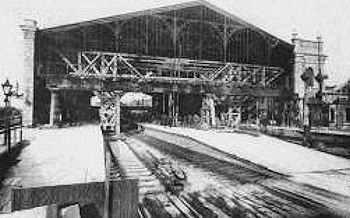 |
Due to its importance as a main and branch line station to both the Bristol and Exeter Railway and later the Great Western, in addition to the London and South West Railway and later the Southern Railway, Exeter St. David's station saw many changes over the years accomodating a very large rail network around the South West.
The Bristol and Exeter Railway opened initially from Bristol to Bridgwater on the 14th of June 1841 with the extension to Taunton by the following year. By 1843, the line had reached Wellington close to Whiteball Tunnel and after the two constuction of the tunnel was completed, Exeter was reached on the 1st of May 1844.
Constructed by the local firm of Hoopers to a design by Isambard Kingdom Brunel, the most popular name for the new station was Red Cow, but thankfully St. David's was chosen. The station consisted of seperate arrival and departure platforms on the 'down' side of the broad gauge line.
On the 30th of May 1846, the South Devon Railway constructed a line from Exeter to Teignmouth. Designed from the outset to work on the atmospheric system, a pumping house was built at the southern end of St. David's, but rebuilt as a water tower 12 months later when the atmospheric system was abandoned.
The Exeter and Crediton Railway - contolled by the London and South Western Ralway - opened on the 12th of May 1851 as a branch from Cowley Bridge into St. David's, with the line being extended into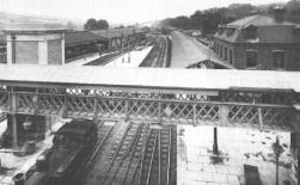 Barnstaple in 1854 and Bideford in 1855. In addition, the LSWR continued their line from Yeovil into a new station at Exeter Queen Street in 1860 and an extension was built into St. Davids in February 1862. Barnstaple in 1854 and Bideford in 1855. In addition, the LSWR continued their line from Yeovil into a new station at Exeter Queen Street in 1860 and an extension was built into St. Davids in February 1862.
As can be imagined, the original single-sided station of 1844 became very cramped with the additional traffic, and recontruction began in 1862 being completed two years later. Designed by Francis Fox, it featured four platforms, a single span pitched roof measuring 363 feet by 132 feet, and a magnificent frontage with 26 ornamental urns. Typically for the Bristol and Exeter Railway, disc and crossbar was the norm, however, when the Great Western absored the B & E in 1876, semaphone signals were installed from 1877.
A further rebuild of the station was made between 1912 and 1914 producing five through platforms and an additional 'down' though line, and platform canopies that replaced Fox's overall roof. The original stone frontage of the station was retained. Later in 1914, more improvements came with the lengthening of the 'up' and middle island platforms, the resiting of the middle signalbox from between the 'up' and 'down' main lines to the 'up' main line. Track circuiting was provided in two stages around the Exeter area.
The 1920's saw the arrival of a weighbridge that was suitable for motor vehicles and additional office accomodation (1923) and signalling alterations at the Exeter West signalbox (1925). In 1926, a petrol bulk storage facility was built and relacement of the 20 ton truck weighbridge by a 30 ton machine from Looe. Additional goods accomodation was provided in 1927, while extended warehouse space was built at the goods station in 1929.
A government sponsored scheme to help the unemployed in 1935, planned a new bridge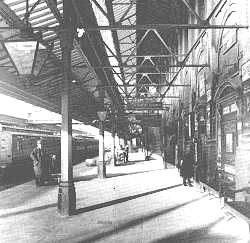 carrying two Souther Railway lines over the GWR lines at the south end of St. David's. The line would then arrive at the west side of the station at a new 850 feet island platform at a higher level. As the goods facilities occupied this part of the site, new goods buildings, and marshalling and mileage yards would be provided at the west side at the north end of the station. In addition, the track between Cowley Bridge and St. David's would be quadrupled. carrying two Souther Railway lines over the GWR lines at the south end of St. David's. The line would then arrive at the west side of the station at a new 850 feet island platform at a higher level. As the goods facilities occupied this part of the site, new goods buildings, and marshalling and mileage yards would be provided at the west side at the north end of the station. In addition, the track between Cowley Bridge and St. David's would be quadrupled.
1938 saw more alterations to the station when a contract was given to W. T. Nicholls Limited for widening of the main building by 11½ feet for a length of 167½ feet, and the construction of a 350 feet canopy along the complete frontage.
To cope with the additional traffic connected with World War II, extensive new marshalling yards were built at Exeter (Riverside) and a new 'down' goods loop was constructed from Cowley Bridge into St. David's. In addition, a new signalbox was built at Exeter (Riverside) in 1943.
At the end of hostilities, Great Western expresses at St. David's handled the passenger services to London (Paddington), Bristol, the Midlands and the North West of England, Kingswear, Plymouth and Penzance. Local services carried passengers to Taunton, Heathfield, Dulverton, Newton Abbot, Paignton and Kingswear (except for summer Saturdays when line occupation prevented this). A substantial service was also provided by the Southern Railway with most trains from Waterloo being divided at Exeter Central before proceeding to St. David's and then on to Plymouth via Oakhampton or Ilfracombe or Padstow. After the Western Region took control of the former Southern lines to Devon and Cornwall in 1963, all Waterloo services finished at or started from St. David's. The ex-Southern route to Plymouth between Okehampton and Bere Alston closed in May 1968 and the northern end of this line between Exeter and Oakhampton closed in June 1972 (this line is now the preserved Dartmoor Railway running between Meldon Quarry and Coleford Junction). The Exeter to Barnstaple line remains open but the line onward to Ilfracombe was closed in October 1970. The ex-GWR local services to Heathfield stopped in June 1958 and to Dulverton in October 1963. The Exeter to Taunton local service was withdrawn in October 1964.
St. David's engine shed was closed to steam in October 1963, however Exeter (Riverside) yard took over the work of Newton Abbot (Hackney) and Tavistock Junction yards in January 1971. In November 1973, the East signal box was closed and the connections that were worked from it were abolished or simplified. In April 1981, the Exeter (Riverside) signalbox closed, while in 1983, work started on a new Power Box at St. David's and when it was fully commissioned in 1988, took over the work of thirty manual signalboxes.
As a footnote to the Exeter St. David's history, after visiting Agatha Christie in Paignton, Allan Lane, a director of the publishers Bodley Head, tried to buy a book at St. David's to read on his journey. Finding only magazines and stuffy Victorian novels at the bookstall, he realised that there was a market for quality but cheap books and the result was that Penguin paperback books were born in 1935.
|
Exeter St. Thomas
Origin: South Devon Railway
Opened: 30th May 1946
|
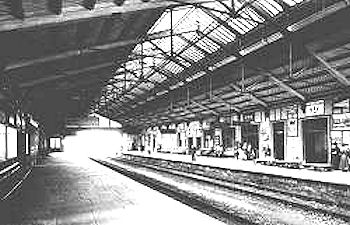 |
Isabard Kingdom Brunel was engaged as the engineer for the South Devon to construct a line between Exeter St. David's station and Plymouth. Initially planned as broad gauge double track line with the first station, Exeter St.Thomas, built on a 548 yards long viaduct.
However, the South Devon Railway was approached by the company that had patented an atmospheric railway system and after much deliberation, Brunel convinced the South Devon Board that this system should be adopted for the total length of the new line. Brunel's main concern against the use of conventional locomotives was that their technology of the day would cause problems on the steep gradients on the line south of Newton Abbot as it approached Totnes and Dartmoor.
To reduce the intial costs of laying the atmospheric pipe complete with pumping houses and stationary steam engines, Brunel modified his original design to a broad gauge single track and Exeter St. Thomas station - initially named St. Thomas (Exeter) - and the line as far as Teignmouth opened on the 30th of May 1846. As the installation of the atmosheric system took all of 1846 and most of 1847, the line utilised conventional locomotives at first until August 1847 when the first atmospheric train reached Teignmouth. however, with so many problems with the design of the stmospheric system meant the South Devon Board decided that atmospheric working would cease on the 9th of September 1848 (for an excellent description and history of the atmospheric system, go to Exeter Memories web site).
A larger ticket office and an overall roof were added to the station in 1847. A small siding to the north of the viaduct was built 1851 for George Hennet for his use as a coal merchant, but this arrangement only lasted for six years. The line between Exminster and St. Davids in 1861 resulting in the widening of St. Thomas' viaduct complete with a second platform, a new two-storey station building and train shed. In 1867, a short branch was opened south of St. Thomas to the basin of the Exeter Canal while in 1903, incandescent lighting was fitted at the station, renamed Exeter St. Thomas in May 1897. In July 1903 the Great Western created the Alphington Road Goods Depot between St. Thomas and the City Basin Junction.
In 1929 and 1930, each of the two platforms were lengthened by 220 feet and the sidings were extended for the use of 19 wagons.
Little change occured at St. Thomas until the 1970's when the overall roof and the train shed were dismantled, and the two-storey station building passed into private ownership. The station is now an unmanned halt for services between Exmouth and Paignton.
|
| |
Fairford
Origin: East Gloucestershire Railway
Opened: 15th January 1873
Closed: Passengers - 18th June 1962
Goods - 2nd November 1970
|
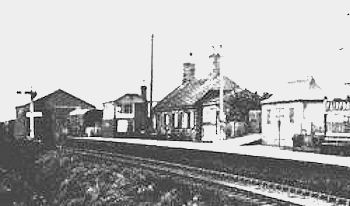 |
The Witney Railway Compant was authorised to construct a line from Yarnton, north west of Oxford to Witney, a busy town on the edge of the Cotswolds famous for its blanket production. The Great Western had originally opposed the building of the line fearing that a competitive through route could be gained from London to Cheltenham by the London and North Western Railway via Yarnton.
Opening in November 1861 and worked by the West Midland Railway, intermediate stations were provided at Cassington, Eynsham and South Leigh.
The proposed East Gloucester Railway was an ambitious scheme to construct a line from Cheltenham to Faringdon, 10 miles north-east of Swindon, with a branch line to Fairford and Witney. This would provide the exact competitive route that the Great Western had feared. To counter this scheme, the GWR offered to guarantee a sum of money for the East Gloucestershire Railway in return for the abandonment of the branch line to Witney. Terms were agreed and the East Gloucestershire Railway was given Royal Approval in August 1862, however, the Great Western withdrew from the agreement believing that the East Gloucestershire did not have the capital to construct their originally planned line from Cheltenham to Faringdon.
An attempt to revive the East Gloucestershire route was made in 1863 with financial backing from the Midland Railway and this was given authorisation in July 1864, however, as a result of the objections made by the Great Western as to the Midland Railway's involvement, Parliament refused to allow the Midland Railway to give financial support to the plan, and again the East Gloucestershire's scheme stalled.
Parliament then allowed the East Gloucestershire an extension of the time to complete the route, but taking stock stock of its financial position, the East Gloucestershire abandoned the planned route from Cheltenham to Faringdon and concentrated its efforts on a line from Witney to Fairford. Opening on the 15th of Jnauary 1873, the single track line ran for 21 miles calling at Brize Norton, Alvescot and Lechlade. Two locomotives were provided from Oxford and sub-shedded at Fairford with boiler washouts and maintenance carried out at Oxford. Unusually, turntables were employed at both Oxford and Fairford and even tank locomotives were turned to face the direction of travel. Those locomotives used on the line included Metro 2-4-0T's, and Collett 57XX, 74XX, Dukedogs and 14XX classes.
Due to the sparsely populated location of the line, very little improvements were made before closure. A new station was opened in 1907 at Kelmscott and Langford, and another was built in 1944 at Carterton to serve the nearby RAF base at Brize Norton. Closure for passengers came swiftly in 1962, but goods traffic remained until 1970.
|
| |
Goodrington Sands Halt
Origin: Great Western Railway
Opened: 9th July 1928
Closed: 1st November 1972 (BR)
|
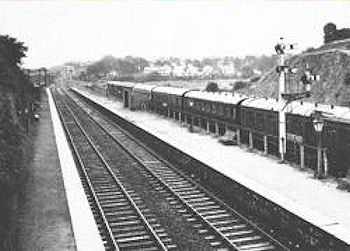 |
As a station, Goodrington Sands Halt was one of the latecomers on the Great Western network. When the Dartmouth and Torbay Railway opened their line on the 14th of March 1861, no station was planned at Goodrington, however during the 1920's, the GWR built several halts, and as the Torbay area was becoming increasing popular for holidays, the station at Goodrington was built in 1928 - one of 28 halts built in that year.
Prior to the opening of the halt, there was a ground frame that controlled the level crossing at Tanners Lane but a new signal box was built together with doubling of the track between Paignton and just north of the level crossing. Initially named Goodrington Halt, the station had one platform, but the track doubling was extended to just south of Goodrinton and a new 'down' platform was added in 1930. The following year saw further changes to the layout when extensive sidings were built on the 'up' side in readiness for the new Paignton Goods Station. In 1933, both platforms of the halt were extended to 600 feet with canopies.
Similar to ExeterSt. David's station, the government backed scheme to help the unemployed in 1935, proposed a group of carriage sidings to eleviate stock to be taken from Newton Abbot, and a roadbridge to replace the level crossing. Unfortunately, World War II postponed this work and the only building that was carried out was the construction of the road bridge abutments.
It was in 1955 that the building of the carriage sidings finally took place, complete with a 65 feet turntable and locomotive watering facilities. The new road bridge was also completed in 1957 onto which a booking office was sited and a stairways giving access to the platforms.
Similar to other parts of the rail network, the 1960's brought many changes to Goodrington Sands Halt. As steam was replaced by diesel power, the locomotive watering facilities were the first items to be made redundant and the closure of Paignton Goods Station followed in 1967 reducing the number of sidings required at Goodrington. Finally, British Railways closed the line between Paignton and Kingswear and, similar to Churston Station, the Dart Valley Railway took control of the line from the 1st of Novenber 1972. The signal box still stands at Goodrington and is used as staff accommodation.
|
| |
Great Malvern
Origin: Worcester and Hereford Railway
Opened: 25th May 1860
|
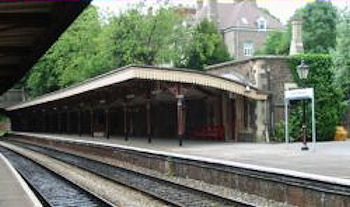 |
If there was ever an award for the UK's prettiest stations, Great Malvern station would easily win the prize. With grand stone buildings, beautiful 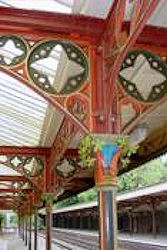 awnings supporting wrought iron columns that look as fresh as the day they were built, Great Malvern station alone is well worth a visit. awnings supporting wrought iron columns that look as fresh as the day they were built, Great Malvern station alone is well worth a visit.
The Worcester and Hereford Railway had completed the section between Worcester Tunnel Junction to Malvern Link by the late 1850's, and extended this line to Great Malvern and Malvern Wells by May 1860. Originally built as a single track, the line was doubled in October 1860. Between these dates, in July 1860, the Worcester and Hereford Railway became part of the West Midlands Railway.
The Midland Railway had also been busy and their line from Ashchurch via Tewksbury and Upton upon Severn, shared the now Great Western station at Great Malvern from May 1864. This service was best described as sparse with only four or five trains in each direction, weekdays only.
Behind the stationmaster's house was a hotel, however this was converted to a ladies college in the 1910's. To assist the young ladies and teachers in the short distance from the station to the college, a covered way was provided. In addition, a siding was built for coal wagons for the use of the college boilers. This siding was removed in October 1956. The 1920's also saw several small sidings built at the station for horseboxes and for the use of items for the station. Public goods traffic was handled at Malvern Link station.
After the termination of the tenancy agreement in March 1943, the Great Western took over the running of the refreshment rooms. In December 1952, the LMS passenger and freight services were withdrawn between Great Malvern and Upton upon Severn.
In March 1965, all of the sidings within the station were made redundant and the signalbox was closed.
|
Copyright © by John Daniel 2013.
|








 to Evesham in 1855, and finally Chipping Camden to Charlbury in 1858.
to Evesham in 1855, and finally Chipping Camden to Charlbury in 1858. Wisbech Produce Canners. As an example of the importance of the freight work at the station, in 1929, it is recorded that Evesham loaded 2,608 fruit wagons in August alone.
Wisbech Produce Canners. As an example of the importance of the freight work at the station, in 1929, it is recorded that Evesham loaded 2,608 fruit wagons in August alone. Barnstaple in 1854 and Bideford in 1855. In addition, the LSWR continued their line from Yeovil into a new station at Exeter Queen Street in 1860 and an extension was built into St. Davids in February 1862.
Barnstaple in 1854 and Bideford in 1855. In addition, the LSWR continued their line from Yeovil into a new station at Exeter Queen Street in 1860 and an extension was built into St. Davids in February 1862. carrying two Souther Railway lines over the GWR lines at the south end of St. David's. The line would then arrive at the west side of the station at a new 850 feet island platform at a higher level. As the goods facilities occupied this part of the site, new goods buildings, and marshalling and mileage yards would be provided at the west side at the north end of the station. In addition, the track between Cowley Bridge and St. David's would be quadrupled.
carrying two Souther Railway lines over the GWR lines at the south end of St. David's. The line would then arrive at the west side of the station at a new 850 feet island platform at a higher level. As the goods facilities occupied this part of the site, new goods buildings, and marshalling and mileage yards would be provided at the west side at the north end of the station. In addition, the track between Cowley Bridge and St. David's would be quadrupled. awnings supporting wrought iron columns that look as fresh as the day they were built, Great Malvern station alone is well worth a visit.
awnings supporting wrought iron columns that look as fresh as the day they were built, Great Malvern station alone is well worth a visit.